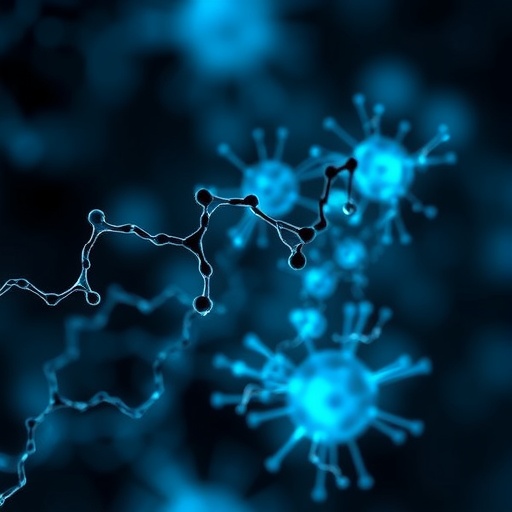
In the relentless battle between the immune system and cancer, tumors employ sophisticated mechanisms to evade destruction, shaping an immunosuppressive microenvironment that shields them from immune attack. Deciphering these evasive tactics, particularly during the initial stages of tumor development, has remained a formidable challenge due to the limitations of existing animal models. Traditional syngeneic mouse tumor models—buttressed by established cancer cell lines—unfortunately fail to recapitulate the evolutionary early phases of tumor immune surveillance and subsequent escape. Now, a groundbreaking study has unveiled a novel approach that not only simulates early immunoediting but also sheds light on a previously underappreciated immune escape mechanism involving necrosis-driven lipid release.
Researchers have pioneered a syngeneic mouse teratoma model derived from noncancerous mouse embryonic stem cells (ESCs), marking a significant departure from conventional models reliant on transformed cells. This innovation allows the tracing of tumor evolution in an immunocompetent context from inception, providing an unprecedented window into the earliest immunoediting events as tumors evolve mechanisms to sidestep immune elimination. Using this model, the team executed a genome-wide CRISPR screen to identify genes that influence these nascent phases of tumor-immune interaction, illuminating new molecular players and pathways implicated in immune evasion.
One of the most compelling findings from this screen was that loss of key pro-apoptotic tumor suppressor genes, including the well-known Trp53, paradoxically fostered an alternative cell death modality: necrosis. Unlike apoptosis, which is immunologically silent or even tolerogenic, necrosis is characterized by cell rupture and release of intracellular contents, which can profoundly impact the tumor microenvironment. In this context, necrosis in teratomas induced by Trp53 inactivation led to the abundant release of APOE-enriched lipid particles into the extracellular milieu, a surprisingly potent factor that modulated immune cell behavior within the tumor.
The study revealed that infiltrating T cells, normally potent agents of immune control, were attracted to areas of tumor necrosis but subsequently became dysfunctional after accumulating these APOE-associated lipids. This state of lipid-induced T cell dysfunction unveils a hitherto unrecognized axis of immune evasion where the tumor co-opts necrosis not just as a destructive force but as a biochemical weapon to suppress anti-tumor immunity. The lipid accumulation led to a profound impairment of T cell effector functions, allowing the tumor to escape immune-mediated eradication.
Crucially, the research team demonstrated that disrupting this harmful lipid uptake by T cells rescued their functionality and restored robust immunosurveillance. By either blocking lipid receptor pathways responsible for APOE uptake or mitigating tumor necrosis through inactivation of the mitochondrial permeability transition pore (mPTP) — a key regulator of necrotic cell death — they were able to reverse T cell dysfunction and potentiate immune-mediated tumor control in their mouse model. This two-pronged approach highlights the therapeutic potential of targeting necrosis-induced immunosuppression.
The mitochondrial permeability transition pore (mPTP) is a critical gatekeeper of cell fate, controlling mitochondrial membrane permeability and, when dysregulated, triggering necrosis. Its role in mediating tumor necrosis and subsequent lipid release outlines a novel therapeutic target that bridges cell death pathways and immune modulation. The ability to pharmacologically or genetically inhibit mPTP function in tumor cells to reduce necrosis and lipid release opens new avenues for restoring immune competence in the tumor microenvironment.
Given that mouse teratomas in this model were enriched for brain-like tissues, the investigators extended their inquiry to human glioblastoma multiforme (GBM), a notoriously aggressive brain cancer with poor prognosis and limited therapeutic options. Examination of human GBM tissues revealed a striking parallel: tumors harboring TP53 mutations exhibited regions of necrosis where infiltrating T cells similarly accumulated APOE-laden lipids and were functionally impaired, implicating the same lipid-mediated immune suppression mechanism in human disease.
This discovery in human GBM underscores the translational relevance of the findings from the mouse teratoma model. GBM’s characteristic heterogeneity and immunosuppressive environment have severely hindered effective immunotherapy approaches to date. By identifying lipid accumulation within T cells as a critical axis of suppression linked to tumor necrosis and TP53 loss, the study offers a mechanistic insight into why GBM tumors can so effectively evade immune destruction despite the presence of tumor-infiltrating lymphocytes.
Importantly, the study tested therapeutic interventions targeting this novel immune escape pathway in preclinical GBM models. Treatment with antibodies against APOE—neutralizing the lipid particles—and anti-PDCD1 (anti-PD1), a checkpoint inhibitor reinvigorating T cell activity, produced synergistic enhancement of antitumor immune responses. This combination therapy not only restored T cell function but also significantly prolonged survival in mice bearing GBM tumors, a powerful proof-of-concept for dual targeting of necrosis-induced lipid immunosuppression alongside classical immune checkpoint pathways.
The synergy between anti-APOE and anti-PDCD1 treatment suggests that lipid-mediated immune dysfunction and checkpoint inhibition operate through complementary mechanisms to dampen anti-tumor immunity. Thus, intercepting both arms may overcome the entrenched immunosuppression characteristic of GBM and possibly other tumors with extensive necrotic microenvironments. This represents a paradigm shift in cancer immunotherapy—a move beyond targeting only immune checkpoints toward also modulating the biochemical milieu imposed by tumor cell death.
On a broader level, this study contributes to a growing recognition that tumor cell death modalities profoundly influence immune responses within the tumor microenvironment. Apoptosis and necrosis differentially shape immune cell recruitment, activation, and function, and this work reveals how necrosis-associated lipid release serves as an unexpected but potent immune suppressive mechanism. Further exploration of the myriad ways in which tumor metabolism and cell death converge to sculpt immune evasion will be crucial for the design of next-generation immunotherapies.
Moreover, this research underscores the value of innovative animal models that capture early tumorigenesis and immunoediting dynamics. The syngeneic teratoma model developed herein, derived from embryonic stem cells rather than established tumor lines, enables studies on how cancers initiate immune escape strategies. Such models are indispensable for unraveling the complexities of tumor-immune co-evolution and for preclinical evaluation of immunomodulatory therapies targeting early events rather than late-stage, immune-edited malignancies.
From a clinical standpoint, the identification of APOE lipid particles as modulators of T cell function raises intriguing possibilities for biomarker development. Measuring levels of APOE or lipid accumulation in tumor-infiltrating lymphocytes could serve as indicators of immune dysfunction and guide patient selection for therapies targeting lipid uptake pathways. Furthermore, drugs designed to inhibit lipid receptors on immune cells, in combination with checkpoint inhibitors, may represent a new therapeutic frontier for solid tumors exhibiting necrosis and immunosuppression.
In sum, this landmark study elucidates a novel mechanism of tumor immune evasion centered on necrosis-induced APOE lipid release and T cell lipid accumulation, linking mitochondrial pore-mediated tumor necrosis to functional impairment of infiltrating immune cells. By uncovering this pathway and demonstrating effective therapeutic interventions in glioblastoma models, it lays the groundwork for transforming our approach to immunotherapy in this devastating disease and potentially others defined by necrotic tumor microenvironments.
As the field moves forward, integrating metabolic, cell death, and immune regulatory pathways will be critical to overcome the entrenched resistance mechanisms tumors deploy. This study marks a crucial stride in that direction, revealing new therapeutic vulnerabilities and inspiring hope for more effective immunotherapies against cancers long considered immunologically “cold.” With continued research and clinical translation, targeting necrosis-associated lipid-mediated immune dysfunction could inaugurate a new dawn in cancer treatment.
Subject of Research: Tumor immune evasion mechanisms; early tumor immunoediting; lipid-mediated T cell dysfunction; cancer immunotherapy; glioblastoma immunology; mitochondrial permeability transition pore in tumor necrosis.
Article Title: Targeting necrotic lipid release in tumors enhances immunosurveillance and cancer immunotherapy of glioblastoma.
Article References:
Ji, Y., Jiang, J., Hu, L. et al. Targeting necrotic lipid release in tumors enhances immunosurveillance and cancer immunotherapy of glioblastoma. Cell Res (2025). https://doi.org/10.1038/s41422-025-01155-y
Image Credits: AI Generated
Tags: CRISPR screen in cancer studiesearly tumor immune surveillanceembryonic stem cells in cancer researchGlioblastoma immunityImmune Evasion Mechanismsimmunosuppressive microenvironmentinnovative cancer research modelsnecrosis-driven lipid releasesyngeneic mouse teratoma modeltracing tumor-immune interactionstumor evolution and immunoeditingtumor lipid release blocking




